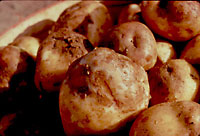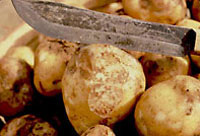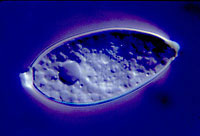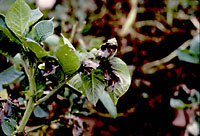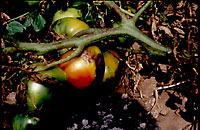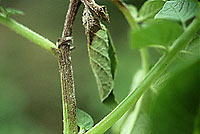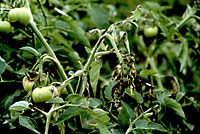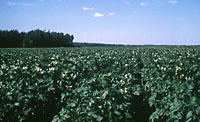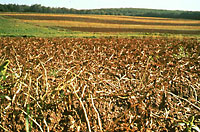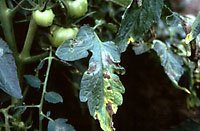Late Blight Disease Cycle
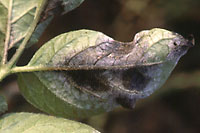
Figure 1A. Late blight lesion on potato foliage |
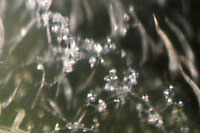
Figure 1B. Lesion as seenthrough a dissecting microscope |
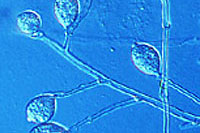
Figure 1C. Micrograph of sporangia |
|
Disease
Cycle |
|||
| In most of the United States and Canada, Phytophthora infestans requires a living host to survive between seasons. Usually it lives in infected potato tubers (Fig. 2), which can survive in storage or the soil (to become volunteers) after harvest or anywhere potatoes might be discarded. Tubers that have been discarded at any stage of crop production or handling (harvest, storage, shipping, spring cleanup, or planting) are known as "culls." Culls may survive if they are not destroyed (frozen, crushed, composted, or buried at least 2 feet beneath the soil surface). Infected tubers that are planted or cull tubers that survive the winter may be sources of the pathogen that initiate epidemics the following season. | |||
|
Figure 2. Potato tubers infected with P. infestans: external symptoms |
Typical granular rot of internal tissues. |
||
|
Figure 3. (left) Sporangia of P. infestans: intact sporagnium |
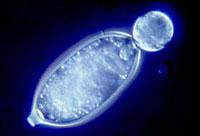
Figure 3. (right) Sporangium from which a zoospore is germinating. |
||
(photos: B. G. Turgeon) |
|||
| P. infestans is usually dispersed aerially one to several miles from the overwintering site to living potato or tomato foliage via sporangia (Figs. 1, 3 left), which can survive exposure to dry, sunny conditions for up to an hour and even longer under cloudy conditions. Sporangia can germinate within a few hours after landing on potato or tomato foliage if free moisture (e.g., dew, rainfall, sprinkler irrigation, fog) is present. Germination takes place either indirectly via zoospores (Fig. 3 right) or directly via a germ tube that penetrates into foliage, stems, or fruit to initiate infections. Infections are visible as small lesions after three to four days. Necrotic areas on some lesions are only 1 to 2 mm in diameter (Fig. 4). Lesions enlarge as the pathogen grows through the tissues, and the pathogen can sporulate from older lesions when the environment is favorable (leaf wetness for more than 10 to 12 hours at moderate temperatures [60º-70ºF]) (Fig. 5). Sporulation may occur on lesions that are only four to six days old. Under dry conditions no sporulation occurs and the lesion has a brown dead center, surrounded by host tissue that has collapsed and appears either water soaked, gray-green, or yellowed (Fig. 6). Both tomato and potato fruits are susceptible (Figs. 7, 8). Their stems may be infected (Figs. 9, 10), and stem lesions are capable of producing sporangia for a longer time than can lesions on leaves. | |||
|
Figure 5. Potato leaflets with older (six to eight days old), sporulating lesions. |
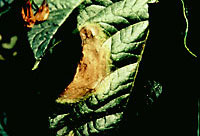
Figure 6. Potato leaflet with
older lesion |
||
|
Figure 7. Tomato fruits infected with P. infestans. |
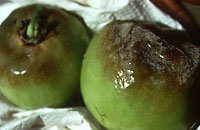
Figure 8. Green Tomato fruits. The pathogen is sporulating from the infected fruits. |
||
(photos: T. A. Zitter) |
|||
| Disease development (growth and reproduction of the pathogen) is favored by moderate temperatures (60º-80ºF) and wet conditions. It can develop in very warm daytime temperatures (ca. 95ºF) if conditions are extremely wet and night temperatures are moderate (60º-75ºF). Epidemics can be rapid and devastating because of the high reproductive potential of this pathogen. Individual lesions can produce 100,000 to 300,000 sporangia per day. Each sporangium is capable of initiating a new infection that will become visible within three to four days and produce sporangia within another day or two under optimal conditions. Thus rapid reproduction of the pathogen and destruction of leaflets can defoliate potatoes or tomatoes and completely destroy healthy fields in a short time (Figs. 11-13). Such epidemics result from many sequential cycles of infections: every lesion produces many sporangia, each of which can be dispersed to a new leaflet to initiate a new infection, which in turn can produce many sporangia, and so on. | |||
|
Figure 9. Potato stem infected with P. infestans |
Figure 10. Infected tomato plants with lesions on stems and foliage (photo: T. A. Zitter) |
||
|
Figure 11. Field of healthy potato plants |
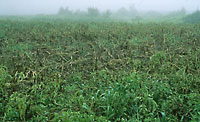
Figure 12. Field of potatoes with severe late blight |
||
| Tubers may be infected by P. infestans whenever sporangia and tubers come into contact, from early in the tuberization process until harvest. Infections most commonly occur when sporangia are washed from lesions on stems and foliage to the soil and then through the soil to tubers. Infections can occur on developing or mature tubers, but contact between tubers and sporangia is more likely when the tubers are enlarging; tuber enlargement creates cracks in the soil and gives sporangia ready access. Tubers become infected most often when soils are cool and wet (near field capacity); soil temperatures higher than 65ºF seem to suppress infections. Because sporangia can survive days or weeks in soil, tubers can become infected for a period of time after infections in the foliage are no longer producing sporangia. | |||
|
Figure 13. Field of potatoes completely destroyed by late blight. (photo: S. B. Goodwin) |
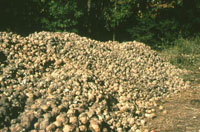
Figure 14. Piles of potatoes discarded owing to infections by P. infestans, followed by severe soft rot. |
||
| Tubers infected by late blight are especially susceptible to soft rot. If some tubers in a crop are infected, store the crop in cool, dry conditions. If infected potatoes are stored at high relative humidity and moderate temperatures, soft rot can be severe, destroying infected tubers first but subsequently destroying previously healthy ones (Fig. 14). | |||
| Infections can probably also occur during harvest and subsequent handling. Although late blight inoculations during storage were previously considered highly unlikely, such occurrences have been documented recently. | |||
| Tomato leaflets (Fig. 15) can be destroyed at least as rapidly as potato leaflets, leading to complete defoliation (Fig. 16) in a short time. | |||
|
Figure 15. Tomato leaflet with late blight lesions. (photo T. A. Zitter) |
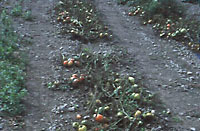
Figure 16. Tomato plants completely defoliated by late blight. |
||
| Useful References | |||

